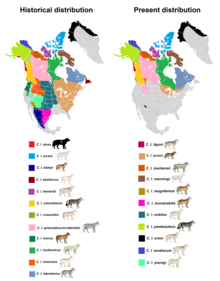| Mogollon mountain wolf | |
|---|---|

| |
| Scientific classification | |
| Domain: | Eukaryota |
| Kingdom: | Animalia |
| Phylum: | Chordata |
| Class: | Mammalia |
| Order: | Carnivora |
| Family: | Canidae |
| Genus: | Canis |
| Species: | |
| Subspecies: | †C. l. mogollonensis
|
| Trinomial name | |
| †Canis lupus mogollonensis Goldman, 1937[1]
| |

| |
| Historical and present range of gray wolf subspecies in North America | |
The Mogollon mountain wolf (Canis lupus mogollonensis) is an extinct subspecies of gray wolf whose range once included Arizona and New Mexico. It is darker than its more northern cousins, and has a highly arched frontal bone.[2]
YouTube Encyclopedic
-
1/1Views:1 630
-
Lincoln National Forest - My Trip to New Mexico
Transcription
Taxonomy
This wolf is recognized as a subspecies of Canis lupus in the taxonomic authority Mammal Species of the World (2005).[3]
Because of its overlapping range with the Mexican wolf (C. l. baileyi), along with the Texas wolf (C. l. monstrabilis), it was proposed by biologists Bogan and Mehlhop for the Mogollon mountain wolf and the Texas wolf to be considered subspecies as the Mexican wolf. This was because the Mogollon mountain wolf was seen as merely a possible middle subspecies between the Mexican wolf and the Southern Rocky Mountains wolf, thus making it unnecessary to distinguish taxonomically. This was accepted by the US Fish and Wildlife Service in 1982 and a "zone of subspecies intergradation" was recognized soon thereafter, extending from the southern Rocky Mountains to the northern tip of the Mexican wolf's range.[4]
The NCBI/Genbank has an entry for Canis lupus mogollonensis[5] and a separate entry for Canis lupus baileyi.
References
- ^ E. A. Goldman (1937). "The Wolves of North America". Journal of Mammalogy. 18 (1): 37–45. doi:10.2307/1374306. JSTOR 1374306.
- ^ Glover, A. (1942), Extinct and vanishing mammals of the western hemisphere, with the marine species of all the oceans, American Committee for International Wild Life Protection, pp. 218-219.
- ^ Wozencraft, W. C. (2005). "Order Carnivora". In Wilson, D. E.; Reeder, D. M. (eds.). Mammal Species of the World: A Taxonomic and Geographic Reference (3rd ed.). Johns Hopkins University Press. pp. 575–577. ISBN 978-0-8018-8221-0. OCLC 62265494. url=https://books.google.com/books?id=JgAMbNSt8ikC&pg=PA576
- ^ Carroll, C., M. K. Phillips, and C. A. Lopez-Gonzalez (2005) Spatial analysis of restoration potential and population viability of the wolf (Canis lupus) in the southwestern United States and northern Mexico[permanent dead link]. Klamath Center for Conservation Research mirror
- ^ "Canis lupus mogollonensis". NCBI.NLM.NIH.gov. National Center for Biotechnology Information, U.S. National Institutes of Health.
External links
- Barry Lopez (2004). Of Wolves and Men. Simon and Schuster. pp. 13–. ISBN 978-0-7432-4936-2.
